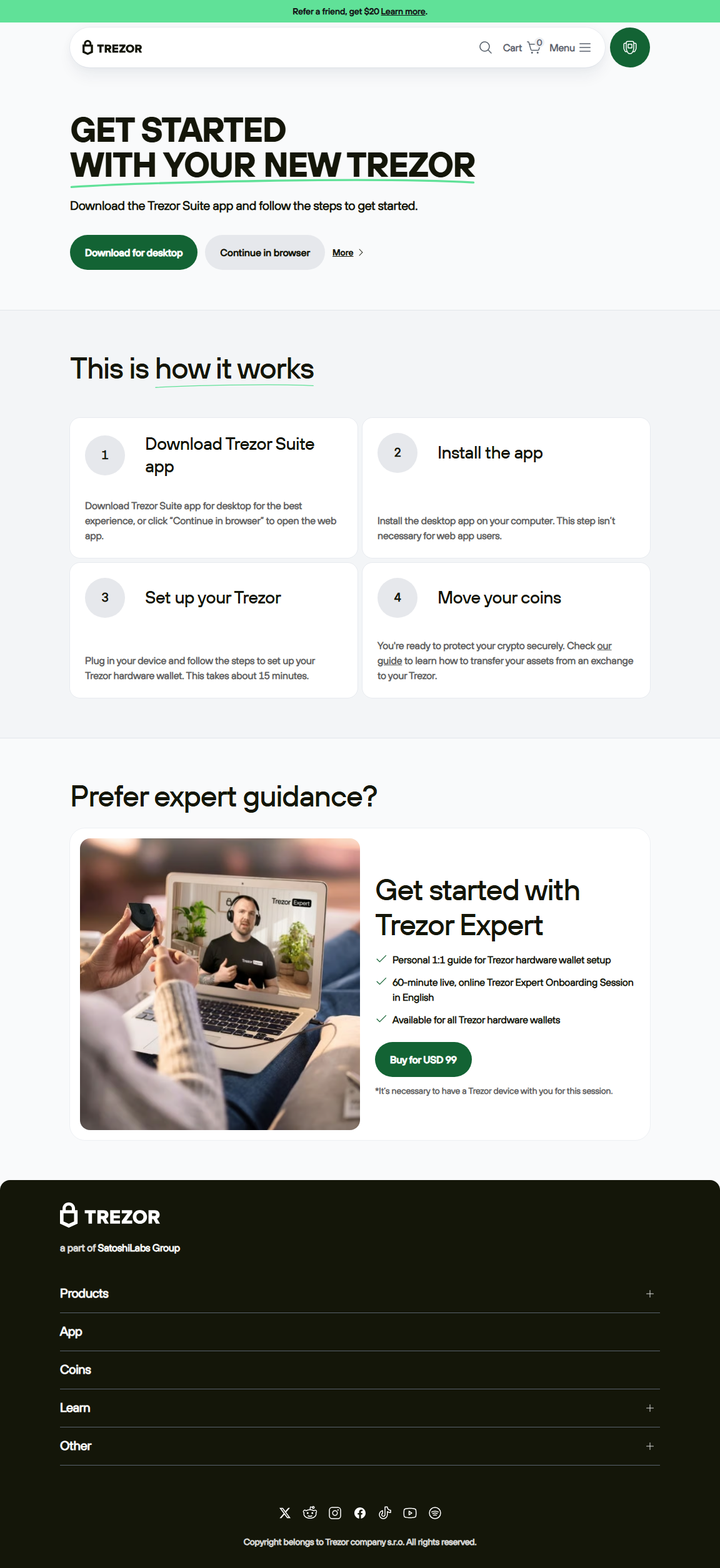Getting Started with Trezor: Your Secure Crypto Foundation
A comprehensive, beginner‑to‑mid‑level guide to setting up your Trezor hardware wallet via trezor.io/start, understanding self‑custody, and navigating the crypto space confidently.
Why Self‑Custody & Trezor Matter
In the world of cryptocurrencies, one of the most critical shifts is taking control of your private keys. Many users use exchanges or hot wallets—and while convenient, they carry risk. A hardware wallet like the Trezor allows you to hold your private keys offline, out of reach of typical online attacks.
Trezor has been around since 2013 and is widely respected for its open‑source firmware and emphasis on security. :contentReference[oaicite:1]{index=1} When you use the setup flow via trezor.io/start, you’re aligning with the manufacturer’s recommended route to reduce threats like phishing or counterfeit devices. :contentReference[oaicite:2]{index=2}
Whether your portfolio contains Bitcoin, Ethereum, or a mix of altcoins, this preparation ensures you’re not only protected from external threats but also educated on terms like “private key”, “seed phrase”, and “cold wallet”.
Step‑by‑Step Setup via trezor.io/start
1. Prepare Your Device & Workspace
Unbox your Trezor device (Model One, Model T, or Safe series), inspect for tampering, ensure the holographic seal is intact, and gather your USB cable, a pen, and paper—your recovery seed will go on paper, not on your computer. :contentReference[oaicite:3]{index=3}
2. Visit trezor.io/start
Open a secure browser and manually type trezor.io/start. Avoid clicking links from emails or search engines. Bookmark this address for future reference. :contentReference[oaicite:4]{index=4}
3. Download & Install Trezor Suite
From the setup portal, download the official Trezor Suite app (desktop version preferred) and follow installation instructions. The software will guide you through firmware updates and device detection. :contentReference[oaicite:6]{index=6}
4. Connect Device & Update Firmware
Plug in your Trezor. The app should detect it and may prompt a firmware update—this is recommended for security and compatibility. Keep the device connected and follow the on‑screen instructions carefully. :contentReference[oaicite:7]{index=7}
5. Set PIN & Generate Recovery Seed
Set a strong PIN that you will remember. The device then generates a 12‑, 20‑, or 24‑word recovery seed that you must write down offline. Do not capture it digitally. Store it securely in more than one place if possible. :contentReference[oaicite:8]{index=8}
Important Crypto & Wallet Terms to Know
- Private Key: The secret code that proves ownership of your cryptocurrencies and allows transactions.
- Seed Phrase / Recovery Seed: A sequence of words that act as a backup for your wallet—necessary for restoring your funds if your device is lost or damaged.
- Cold Wallet: A wallet stored offline, like a hardware wallet, reducing exposure to online attacks.
- Hot Wallet: A wallet connected to the internet (mobile/desktop) used for active or smaller‑value transactions.
- Blockchain: The distributed ledger technology underlying cryptocurrencies, recording transactions immutably.
Trezor Setup Pitfalls & Comparison
| Feature | Trezor (Hardware) | Hot/Software Wallet |
|---|---|---|
| Security | Keys stored offline, device must be physically present | Keys often online, exposed to phishing & malware |
| Convenience | Requires device, setup effort | Always accessible via phone/computer |
| Trust Model | You control the keys (self‑custody) | Often third‑party custody or dependency |
| Best Use | Long‑term holdings, high value funds | Everyday usage, small amounts, trading |
Tip: Use a hardware wallet like Trezor for your main holdings and a hot wallet for everyday transfers.
"When you hold your keys, you hold your crypto destiny – a Trezor hardware wallet and the right setup flow make that control real."
Frequently Asked Questions (FAQ)
Is Trezor safe for beginners?
Yes. The guided setup via trezor.io/start walks you step‑by‑step, and once configured properly, your crypto lives securely offline.
What if I lose my device?
Your recovery seed allows you to restore your funds on a new device. As long as you kept that phrase safe, you're covered.
Can I add many coins and tokens?
Yes. Trezor supports a wide variety of assets via Trezor Suite, allowing you to manage multiple accounts in one place.
How do I avoid phishing when using Trezor?
Always type trezor.io/start manually into your browser, verify the SSL certificate, never follow email links, and never share your seed phrase. :contentReference[oaicite:9]{index=9}
Take Control of Your Crypto with Trezor Today
Whether you’re a new crypto user or have been navigating this space for a while, the setup path through trezor.io/start is your best entry point to reliable, self‑custodied security. Follow the steps, write down that seed phrase, and give yourself peace of mind knowing you control your keys, your funds, and ultimately your crypto journey.
